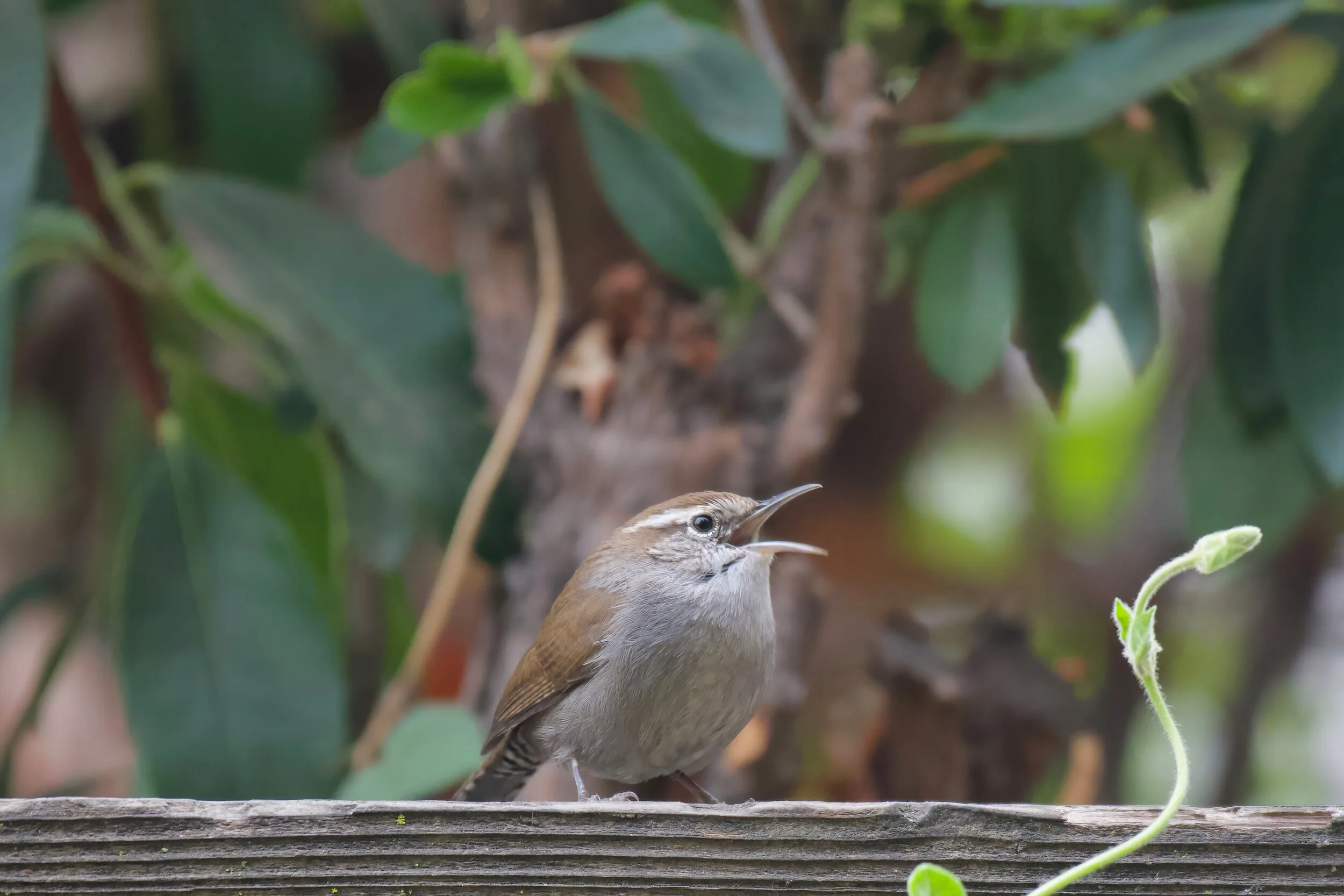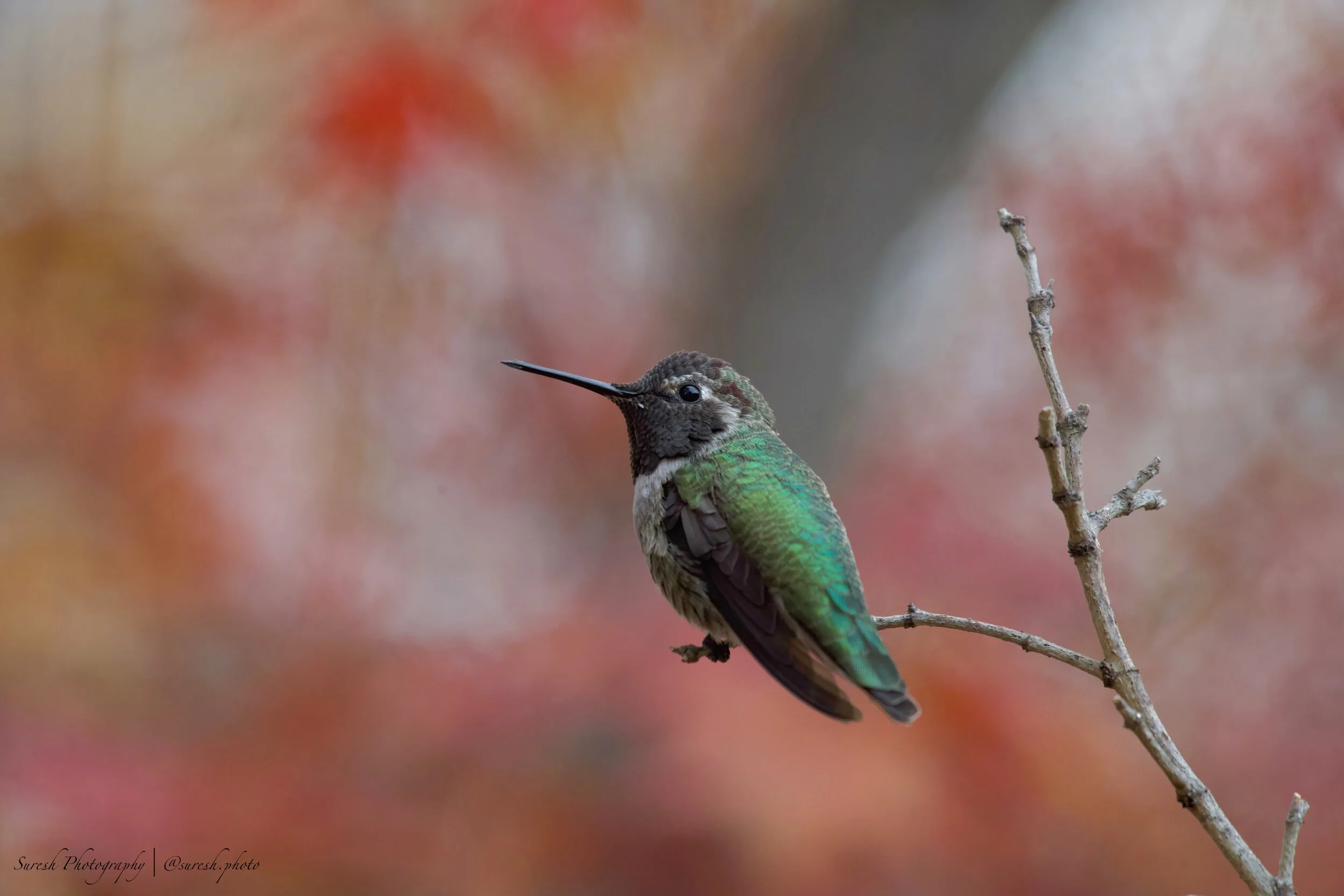Sparrows are Here and Winter is Coming!
BY JULIE AMATO
It’s the middle of October, and despite the mini heat wave we’re experiencing, a Hermit Thrush took an exploratory stroll around our yard yesterday. The arrival of this winter bird tells me that the seasons are indeed changing. Each week brings new visitors to our yard, joining our year-round residents at our feeders.
Highlights of the past month
This October has been the Month of the Sparrow in our yard.
An Adult White-crowned Sparrow in our yard
White-crowned Sparrows, faithful winter residents of Santa Clara County, first arrived in our yard in mid-September, showing up in one’s or two’s. Early one October morning, I opened the blinds and discovered a dozen of them, briskly foraging on the ground. The White-crowned’s had arrived, in force! They are now a constant presence in our yard, in mixed groups of adults and juveniles - look for black and white crown stripes on the adults and brown and gray crown stripes on the young ones. Their songs, melodic trailing whistles, float through the air and reach me throughout the day. (White-crowned’s songs are well studied, and the birds are known to have different dialects depending on where they live.)
A Lincoln’s Sparrow pays us a visit
Mixed in with that group of a dozen White-crowneds was a small sparrow that looked like it had been dipped in soot. My mind registered it as some sort of aberrant crowned sparrow, but when I looked more closely, I suspected that it was a different species. After days of waiting for the bird to show up, and several mishaps of not being quick enough with my camera, I finally snapped some blurry photos of this shy bird. To my delight, my visitor was a Lincoln’s Sparrow, a first for our yard and a first for me!
A Golden-crowned Sparrow forages in our yard
Golden-crowned Sparrows, also winter residents, are arriving from the north too. They appeared in our yard about a week after we saw our first White-crowned’s, and so far have been less numerous. One day I watched a Golden-crowned that had plonked itself squarely in the middle of our platform feeder, munching sunflower seeds and defending the feeder from some bemused House Finches that were used to dominating their favorite food cache. UC Santa Cruz researchers have found that Golden-crowned’s have rich social lives - they live in communities and form lifelong friendships.
I mentioned in my last post that Yellow-rumped Warblers arrive like clockwork in our neighborhood in early October - last year, I recorded my first yard sighting on October 3. I am happy to report that this year, our first Yellow-rumped of the winter showed up on...October 3! A coincidence, yes, but delightful nonetheless.
Our year-round resident birds are still here and getting ready for the winter. Male House Finches are getting redder, with color slowly spreading like a blush across their heads and breasts; the color is still quite pale, not the deep fire-engine red of later in the winter. Dark-eyed Juncos, on the other hand, mostly seem to have their adult plumage now - well-defined black hoods contrasting with their pink bills and brown backs.
Nuttall’s Woodpecker at our bird bath
The Chestnut-backed Chickadees in our yard have had a lot to say lately - on two separate days, I listened as they loudly called back and forth for extended periods of time, in the first case for a full eleven minutes (yes, I timed it!)! They were alone in the yard during this sequence, and I wondered what they were talking about. We have watched a White-breasted Nuthatch conduct a thorough inspection of overhead wires - my husband saw it glean a spider from out of a tangle of wire. Nuttall’s Woodpeckers drum on poles, and one has been spotted several times taking a quick sip from our bird bath. Occasionally we think we hear a Barn Owl at night - a scream overhead, then silence. Of course, whenever we wait and listen for it, it never obliges. Its ephemeral nature only increases our thrill when we are lucky enough to hear it.
What’s happening in November
Right now, I’m getting ready for the annual start of Project FeederWatch, a citizen science project organized by the Cornell Lab of Ornithology. Each winter, together with tens of thousands of others across the U.S. and Canada, I count birds in my yard and submit the information to the Lab. The data are analyzed by scientists to help us better understand trends in bird populations. FeederWatch starts in November. Participation is simple and fun, a natural extension of backyard birding - consider joining in!
Our first Yellow-rumped Warbler this winter
In November, I’m expecting to see and hear Yellow-rumped Warblers more frequently - listen for their squeaky chek call as they flit through your backyard trees. These birds are too shy to come to my feeders, unlike the Townsend’s Warbler. This small yellow-and-black warbler with the Lone Ranger mask showed up at our feeders for the first time last November; a male Townsend’s was a daily visitor throughout the winter.
In the woodpecker family, we are still waiting to catch a glimpse of a Red-breasted Sapsucker, newly arrived from its summer grounds further north. Tapping on a tree, and a flash of a blazing red head, will alert you to this bird’s presence. One of our largest woodpeckers, the Northern Flicker, will sometimes show up in backyard trees during the winter. Look for a big bird with a heavily spotted breast and colorful tail feathers. A bright red splash of a moustache marks the males of the red-shafted subspecies (the most common type in our area). The birds make a variety of loud calls that will let you know that they have arrived.
Ruby-crowned Kinglets occasionally pass through our yard in the winter - last year, I saw our first one in November. These tiny olive-green balls can be identified by their compact shape and large eyes highlighted by pale eye-rings. They are rarely still, preferring to flit in the trees rather than come to feeders.
If you have trees with berries in your yard, be on the outlook for Cedar Waxwings, which may arrive in large flocks to gorge themselves on the fruit. They make a soft high-pitched wheezing sound that is unmistakable once you’ve learned it. And finally, American Robins often congregate in yard trees in the winter - in the past, they’ve started to arrive in my yard in November.
Getting into backyard birding
Just like us, birds have a rhythm and pattern to their days. Try observing your yard or patch at different times of the day. Who are the “early birds”? Who closes out the day? Who is active in the middle of the day? If you watch and listen regularly, you’ll soon be able to predict which birds you’re likely to see when.
What birds are in your yard?
What are you seeing and hearing in your yard now? All observations are good, and species ID’s aren’t necessary! (In fact, we can help with that.) Drop us a note or send a photo or sound clip to backyardbirds@scvas.org. We’ll share a sample of submittals on our website.
More resources
This winter, count birds at home for science! Project FeederWatch, a citizen science project from the Cornell Lab of Ornithology, starts in November. For information about how to participate, see the FeederWatch website or sign up for their introductory webinar.
For more information about backyard bird feeding, see our Backyard Birding page.
To learn more about backyard bird species, see our list of common backyard birds in Santa Clara County and read all about our backyard bird of the month.
Julie’s Backyard Bird List (September 23 - October 20, 2020)
Mourning Dove
Anna’s Hummingbird
Turkey Vulture
Cooper’s Hawk
Barn Owl (maybe!)
Nuttall’s Woodpecker
Black Phoebe
California Scrub-Jay
American Crow
Chestnut-backed Chickadee
Oak Titmouse
White-breasted Nuthatch
Bewick’s Wren
Northern Mockingbird
Hermit Thrush
House Finch
Lesser Goldfinch
Dark-eyed Junco
White-crowned Sparrow
Golden-crowned Sparrow
Lincoln’s Sparrow
California Towhee
Yellow-rumped Warbler
Photo Credits:
White-crowned Sparrow by Brooke Miller (top)
All other photos by Julie Amato and Francesco Meschia
























